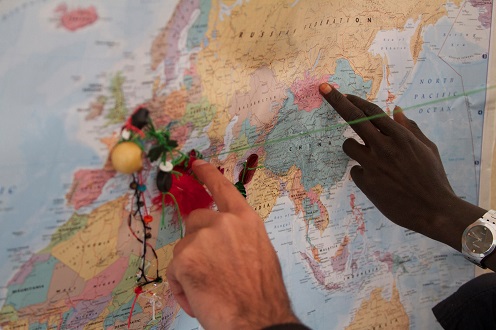
Art Programs in Calais Bring Humanity Back to the Lives of Refugees
29 August 2017
The British Association Of Art-Therapists
Written by Isabel Soloaga
Through the artistic expression enabled by Art Refuge UK in Calais and echoed in the work of artists around the globe, refugees are reclaiming their identity as human beings despite the methodological dehumanization they face in the media, public policies and police brutality…
Riot police in “The Jungle” of Calais, a refugee camp on the border of France and the UK, sprayed tear gas into one young refugee’s dinner last week.
The boy, around 13 years old, lives unaccompanied in the town’s dump. His dream is to reach the UK. That afternoon, men and boys traced their journeys from homes in Eritrea, Afghanistan, the Sudan and other faraway, war torn countries using the maps and art supplies brought to Calais by Art Refuge UK, a small charity that offers art therapy groups in various spaces in and around town alongside their French partners Secours Catholique and Medecins du Monde. The exhausted individuals gathered could finally share their stories, embracing a new mode of self-expression through which to tell them: art.
“I’m made of the same stuff as you,” one boy, absorbed in his painting, told Mary Rose Brady, Director of Operations, British Association of Art Therapists, when she visited Calais. “People should love me.”
…/…
“They are being treated like animals,” said Clare Moseley, founder of the UK based nonprofit Care4Calais, to a team of volunteers huddled together in the icy wind of the intact camp last November. Today, the nonprofit cites that human rights violations in the camp are worse than ever. Since Human Rights Watch published their report last month, “It has been the refugees who are facing the backlash,” said Naomi Press, an art therapist who has worked in the Jungle for over two years with Art Refuge UK.
However, determined artists like 19 year old photographer Abdulazez Dukhan and Allan deSouza, chair of UC Berkeley’s Visual Arts program, are working to challenge, subvert and provide alternatives to the mainstream media’s representation of refugees which depict them, in deSouza’s words, as “either terrorists or victims.”
Dukhan, who fled Syria three years ago, now lives in a refugee camp in Belgium. As he says, “We’re just regular people wanting to get back to our ordinary lives.”
Through the artistic expression enabled by Art Refuge UK in Calais and echoed in the work of artists around the globe, refugees are reclaiming their identity as human beings despite the methodological dehumanization they face in the media, public policies and police brutality.
“It’s very difficult in Calais right now,” says Bobby Lloyd, CEO of Art Refuge UK. She would know. Her organization, which brings skilled and experienced HCPC registered art therapists into the Calais area, has been on the ground every week for over two years now. She has witnessed the growth of the camp, two demolition attempts by the French government, and, now, a string of human rights abuses. “Boys come in, and they want to tell us their stories,” says Lloyd. “They want to tell us how the police tear gassed their food.”
Pour lire l’article, cliquez sur l’image

